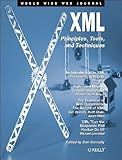Best Tools for Merging XML Documents to Buy in December 2025

Beginning XML
- QUALITY ASSURANCE: AFFORDABLE BOOKS WITH MINIMAL WEAR AND TEAR.
- ECO-FRIENDLY CHOICE: SAVE MONEY AND SUPPORT RECYCLING EFFORTS.
- WIDE SELECTION: EXPLORE DIVERSE GENRES AT UNBEATABLE PRICES!



XML and FrameMaker



Professional XML Development with Apache Tools: Xerces, Xalan, FOP, Cocoon, Axis, Xindice



XSLT Jumpstarter: Level the Learning Curve and Put Your XML to Work



Xml: Principles, Tools, and Techniques
- AFFORDABLE PRICING FOR QUALITY PRE-LOVED READS.
- RELIABLE CONDITION GUARANTEE FOR PEACE OF MIND.
- ECO-FRIENDLY CHOICE SUPPORTS SUSTAINABLE READING.



XML Hacks: 100 Industrial-Strength Tips and Tools
- AFFORDABLE PRICES ON QUALITY USED BOOKS FOR BUDGET-CONSCIOUS READERS.
- ENVIRONMENTALLY FRIENDLY CHOICE-REDUCE WASTE BY BUYING USED!
- RELIABLE SELECTION-PRE-OWNED BOOKS IN GOOD CONDITION, READY TO READ.



Perl Hacks: Tips & Tools for Programming, Debugging, and Surviving
- AFFORDABLE PRICES: QUALITY READS WITHOUT THE HEFTY PRICE TAG!
- ECO-FRIENDLY CHOICE: GIVE USED BOOKS A SECOND LIFE AND SAVE TREES!
- VARIED SELECTION: DISCOVER UNIQUE TITLES NOT FOUND IN STORES!



Writing Compilers and Interpreters: A Software Engineering Approach


To merge multiple XML documents, you can follow these steps:
- Open all the XML documents that you want to merge.
- Create a new empty XML document, which will serve as the merged output.
- Copy the root element from one of the XML documents into the new merged document.
- For each XML document, excluding the first one, copy the content inside the root element and append it to the corresponding section in the merged document.
- Continue this process for all the XML documents you want to merge.
- Save the newly created merged document.
By following these steps, you can combine the contents of multiple XML documents into a single XML file. It's important to ensure that the structure of the XML documents being merged is compatible and consistent for a successful merge operation.
How to merge multiple XML documents using PHP?
To merge multiple XML documents using PHP, you can follow these steps:
- Create a new DOMDocument object:
$mergedDocument = new DOMDocument('1.0', 'UTF-8'); $mergedDocument->preserveWhiteSpace = false; $mergedDocument->formatOutput = true;
- Load the first XML document into the DOMDocument object:
$firstDocument = new DOMDocument(); $firstDocument->load('first.xml');
- Import the root element of the first document into the merged document:
$root = $mergedDocument->importNode($firstDocument->documentElement, true); $mergedDocument->appendChild($root);
- Load the second XML document:
$secondDocument = new DOMDocument(); $secondDocument->load('second.xml');
- Import each element inside the second document and append it to the root element of the merged document:
$secondElements = $secondDocument->getElementsByTagName('*'); foreach ($secondElements as $element) { $imported = $mergedDocument->importNode($element, true); $root->appendChild($imported); }
- Repeat steps 4 and 5 for each additional XML document you want to merge.
- Finally, save the merged document to a file:
$mergedDocument->save('merged.xml');
Note: Make sure the XML files are accessible to the PHP script and adjust the file paths accordingly.
Remember to handle any error conditions and ensure that the XML files are well-formed to avoid potential issues during the merge process.
How to merge multiple XML documents using XML namespaces?
To merge multiple XML documents using XML namespaces, you can follow these steps:
- Identify the XML namespace declarations present in each document. XML namespaces allow elements and attributes to be uniquely identified even if they have the same name.
- Ensure that the XML namespace prefixes used in each document are unique. If there are conflicting prefixes, you will need to modify them to make them unique within the context of merging.
- Create a new XML document that will serve as the merged result. This document should include the necessary namespace declarations from all the source documents. For example, if the source documents have namespace declarations like xmlns:ns1="http://example.com/namespace1" and xmlns:ns2="http://example.com/namespace2", the merged document should include both of these.
- Copy the elements from the source documents into the merged document. While doing this, update the namespace prefixes used for the elements and their attributes, if required, to match the prefixes declared in the merged document. Ensure that the namespace URI (uniform resource identifier) remains the same.
- Repeat the previous step for each source document, taking care to update the namespace prefixes as needed.
- Save the merged document.
Here is a simple example showcasing the merge of two XML documents with different namespaces (using Python's xml.etree.ElementTree module):
import xml.etree.ElementTree as ET
Load the source documents
tree1 = ET.parse("doc1.xml") tree2 = ET.parse("doc2.xml")
Get root elements of the source documents
root1 = tree1.getroot() root2 = tree2.getroot()
Merge the documents by copying elements from root2 to root1
for elem in root2.iter(): # Update the namespace prefix if required if elem.tag.startswith('{http://example.com/namespace2}'): elem.tag = '{http://example.com/namespace1}' + elem.tag[28:]
# Append the element to root1
root1.append(elem)
Save the merged document
tree1.write("merged.xml")
Note that this example assumes the target namespace (http://example.com/namespace1) will be used for merged elements and attributes. You can modify the code accordingly based on your specific requirements and namespaces.
How to merge XML documents using a specific element as a key?
To merge XML documents using a specific element as a key, you can follow these steps:
- Parse the XML documents: Start by parsing the XML documents to extract the necessary elements and data. You can use an XML parsing library or method provided by your programming language of choice.
- Identify the key element: Determine the specific element that will serve as the key for merging the documents. This element should be present in all the XML documents you want to merge.
- Create a data structure: Define a data structure (e.g., dictionary, map, or object) that will hold the merged data. The key element's value will serve as the key in this data structure, with associated values being the merged data.
- Iterate over the documents: Iterate over each document and for each occurrence of the key element: Retrieve the value of the key element. Check if the value exists as a key in the data structure. If it does, retrieve the associated value. If it doesn't, initialize an empty value. Merge the remaining elements of the current document under the key value. Store the merged data in the data structure with the key value.
- Convert the merged data to XML: Once you have merged the data, convert it back to XML format. You can use an XML generation library or build the XML structure manually.
- Save the merged XML document: Finally, save the merged XML document to a file or use it for further processing as needed.
Note: The specific implementation details may vary depending on the programming language and libraries you are using.
How to merge multiple XML documents using C#/.NET?
To merge multiple XML documents using C#/.NET, you can follow these steps:
- Create an empty XmlDocument object to store the merged XML document. XmlDocument mergedXmlDoc = new XmlDocument();
- Load each XML document into its own XmlDocument object. XmlDocument xml1 = new XmlDocument(); xml1.Load("path/to/xml1.xml"); XmlDocument xml2 = new XmlDocument(); xml2.Load("path/to/xml2.xml"); // Load more XML documents if needed
- Iterate through each child node of the first XML document and import them into the mergedXmlDoc. foreach (XmlNode node in xml1.DocumentElement.ChildNodes) { XmlNode importedNode = mergedXmlDoc.ImportNode(node, true); mergedXmlDoc.DocumentElement.AppendChild(importedNode); }
- Repeat Step 3 for each additional XML document you want to merge. foreach (XmlNode node in xml2.DocumentElement.ChildNodes) { XmlNode importedNode = mergedXmlDoc.ImportNode(node, true); mergedXmlDoc.DocumentElement.AppendChild(importedNode); }
- Save the mergedXmlDoc to a file or perform any other necessary operations. mergedXmlDoc.Save("path/to/mergedXml.xml");
By following these steps, you can merge multiple XML documents into a single XML document using C#/.NET.
